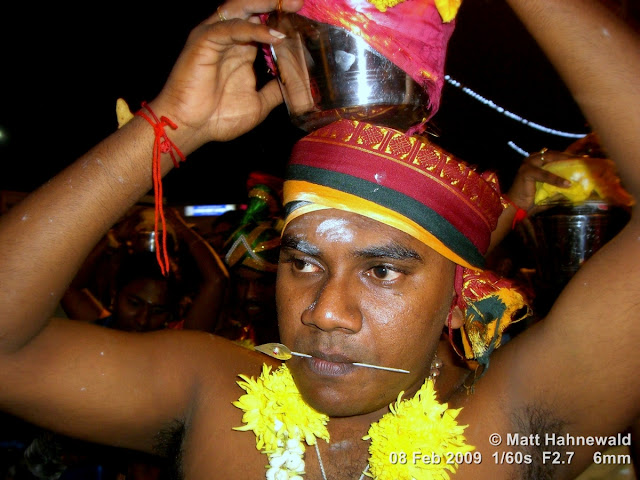Thaipusam is a Hindu festival celebrated mostly by the Tamil community on the full moon in the Tamil month of Thai (January/February). In Malaysia, the temple at Batu Caves, a limestone hill with a series of caverns and temples about 12 km north of Kuala Lumpur, attracts over one million devotees, many of them with body
piercings that would make a medic cringe...
Celebrated by Kuala Lumpur's Indian community, Thaipusam is one of the best times to visit Batu Caves. 272 steps lead to the top and just inside the front door, piles of stone slabs have fashioned out a sort of Norman arch that frames a giant, granite-carved statue of Lord Subramanian.
The main Thaipusam event takes place at the base of the hill where devotees start preparing to perform ritual acts of thanksgiving or penance. First, Hindu priests aka pujaris "bathe" them in the river by the caves, with many of them going into trances from the ritualistic prayers. They are then lanced and skewered with metal hooks, needles or spikes - a seemingly painless process because of the trance. Family and friends then guide devotees up the stairs to the main grotto of the caves, where they perform more prayers. Besides impaling themselves, followers also carry giant metal constructions (called kavadis) with offerings such as flowers and milk to the top of the caves. Some kavadis can weigh up to as much as 100 kg. Once prayers are completed, those with skewers attached to their bodies have them removed and their wounds are treated. The event continues throughout the night and into the next day with many queuing up to carry their kavadis up to the central cavern. After two days at Batu Caves the procession returns to Sri Mahamariamman Temple with thousands of people walking alongside it and performers keeping morale up with drums beating out a driving rhythm.
Celebrated by Kuala Lumpur's Indian community, Thaipusam is one of the best times to visit Batu Caves. 272 steps lead to the top and just inside the front door, piles of stone slabs have fashioned out a sort of Norman arch that frames a giant, granite-carved statue of Lord Subramanian.
The main Thaipusam event takes place at the base of the hill where devotees start preparing to perform ritual acts of thanksgiving or penance. First, Hindu priests aka pujaris "bathe" them in the river by the caves, with many of them going into trances from the ritualistic prayers. They are then lanced and skewered with metal hooks, needles or spikes - a seemingly painless process because of the trance. Family and friends then guide devotees up the stairs to the main grotto of the caves, where they perform more prayers. Besides impaling themselves, followers also carry giant metal constructions (called kavadis) with offerings such as flowers and milk to the top of the caves. Some kavadis can weigh up to as much as 100 kg. Once prayers are completed, those with skewers attached to their bodies have them removed and their wounds are treated. The event continues throughout the night and into the next day with many queuing up to carry their kavadis up to the central cavern. After two days at Batu Caves the procession returns to Sri Mahamariamman Temple with thousands of people walking alongside it and performers keeping morale up with drums beating out a driving rhythm.
High-res portrait photographs with full exif data, geotags and technical details in Matt Hahnewald's
Flickr Album 2018-01a Recelebrating Ecstatic Thaipusam
Flickr Album 2018-01a Recelebrating Ecstatic Thaipusam










No comments:
Post a Comment